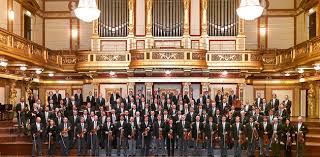|
Symphony
FROM THE NEW WORLD TO THE OLD WORLD
by Peter Lert
Saturday, June 14, 2025
Chamber
MC2 DUO RECITAL CLOSES 222'S SEASON
by Terry McNeill
Saturday, June 14, 2025
Choral and Vocal
CANTIAMO SONOMA'S LUSCIOUS A CAPELLA SINGING IN SEASON ENDING CONCERT
by Pamela Hicks Gailey
Sunday, June 8, 2025
Symphony
SRS SEASON ENDS WITH RESOUNDING TA-TA-TA-BANG
by Terry McNeill
Sunday, June 1, 2025
Symphony
YOUTHFUL VIRTUOSITY ON DISPLAY AT USO'S MAY CONCERTS
by Peter Lert
Saturday, May 17, 2025
Symphony
MYSTICAL PLANETS AND LIVELY GERSHWIN ORTIZ AT FINAL SRS CONCERT
by Peter Lert
Sunday, May 4, 2025
Symphony
VSO'S CONCERT MUSIC OF TIME, MUSIC OF PLACE
by Peter Lert
Sunday, April 27, 2025
VOCAL ELEGANCE AND FIRE AT THE 222'S RECITAL APRIL 26
by Pamela Hicks Gailey
Saturday, April 26, 2025
CANTIAMO SONOMA SINGS AN INSPIRED GOOD FRIDAY MOZART REQUIEM CONCERT
by Pamela Hicks Gailey
Friday, April 18, 2025
DRAMATIC SHOSTAKOVICH SYMPHONY CLOSES PHILHARMONIC'S 25TH SEASON
by Terry McNeill
Sunday, April 13, 2025
|
 |
 Vienna Philharmonic Orchestra |
BE EMBRACED, YOU MILLIONS
by Steve Osborn
Tuesday, March 11, 2014
Mere prose is inadequate to describe how good the Vienna Philharmonic was at Weill Hall on March 11, but perhaps a waltz title will do the job. How about "Seid umschlungen, Millionen" (Be embraced, you millions)? That was the Johann Strauss encore the orchestra played after their superlative guest conductor, Andris Nelsons, was repeatedly called back to the stage at concert's end.
"Be embraced" was the theme throughout the evening, from the opening bars of Haydn's 90th symphony, through Brahms' "Variations on a Theme by Haydn," into more Brahms--the Symphony No. 3--and culminating in the Strauss waltz, which was actually dedicated to Brahms. Instead of millions, there were only 1,400 patrons in the packed hall, but the millions--billions?--must include all the other patrons who have heard the Vienna Phil over its storied history, a history that continues to be shaped by conductors such as Nelsons and by legions of superb musicians.
The applause started even before the concert began, when a select portion of the Vienna Phil, including a few female violinists and cellists, strode onstage. Old chauvinist traditions die hard, but Vienna is making progress. They had barely settled in when Nelsons walked on as well, clad only in black, without the traditional jacket.
Holding a baton in his right hand, Nelsons grasped the rail at the back of the conductor's podium like a ballerina and then proceeded to mimic a ballerina throughout the evening. Nelsons is a conductor for whom no motion is out of bounds, whether pointing skyward like a celebrant or twirling like a top. His hands and feet are in constant movement, and his baton passes from right to left incessantly. At times, he launches forward into each section of the orchestra, hovering over them like a hawk. He seems to have a different conducting method for every musical passage he encounters.
The first such encounter was the opening Allegro of the Haydn, played impeccably and vivaciously. One often hears Haydn's late "London" symphonies, including the famous "Surprise," but the slightly earlier Parisian counterparts, including No. 90, are just as beguiling. The invention is delightful, the color abundant and the spirit uplifting.
The subsequent Andante settled into a blissful repose marked by a terrific flute solo that found Nelsons conducting with his fingers. For the ensuing Minuet, he stood on his left foot, the better to coax an astounding range of dynamics out of his bewitched subjects. The sprightly Finale wrapped it all up with strong accents, a complete unanimity of sound, and a furious pace leading to ultimate serenity.
More Haydn was in store for the next piece, first literally, and then as fodder for the fertile imagination of Brahms. The "Variations on a Theme by Haydn" was the breakthrough that allowed Brahms to compose his own four symphonies. You can almost hear him discovering his mature style as he mines the rich veins of the first symphonic master.
The opening theme, from Haydn's "Chorale St. Antoni," was stately and well controlled. Nelsons emulated the stately aspect through stricter use of his baton, but by the first variation, he was back to his old tricks, switching the baton from left to right and prancing upon the podium like a man possessed. The eight variations were as different from one another as a polyglot menagerie, ranging from the liquescent (No. 3), to the mysterious (No. 4), to the festive (No. 6). The sound throughout was incredibly rich and impeccably balanced. The brass never overwhelmed the strings, and the woodwinds shone through like sunbeams.
In the second half, given over to the Brahms Symphony No. 3, Nelsons assumed the role of an underwater swimmer, shaping the orchestra's aqueous sound through fluid motions unchallenged by gravity. The pace in the opening Allegro was luxurious, but underlain with a tense expectancy. The players repeatedly turned on a dime, unleashing explosive energy and then floating as if on a cloud.
In the Andante, Nelsons put a finger on his ear as if checking for intonation, but everything seemed perfect. The players once again demonstrated that mastery is not just how loud an orchestra plays, but also how softly. The quiet passages were at the edge of hearing.
The famous cello theme that opens the third movement passed seamlessly around the orchestra, culminating in an evocative horn solo. In the Finale, the subdued opening gave way to a full release of the potential energy that had been gathering all evening. A flurry of down bows from the violins ushered in a thrilling, almost demonic, ride to the muted end, where Nelsons waved his hand in the air in a kind of sad farewell to a magical evening. He was a joy to watch, and his musicians a joy to hear.
|
